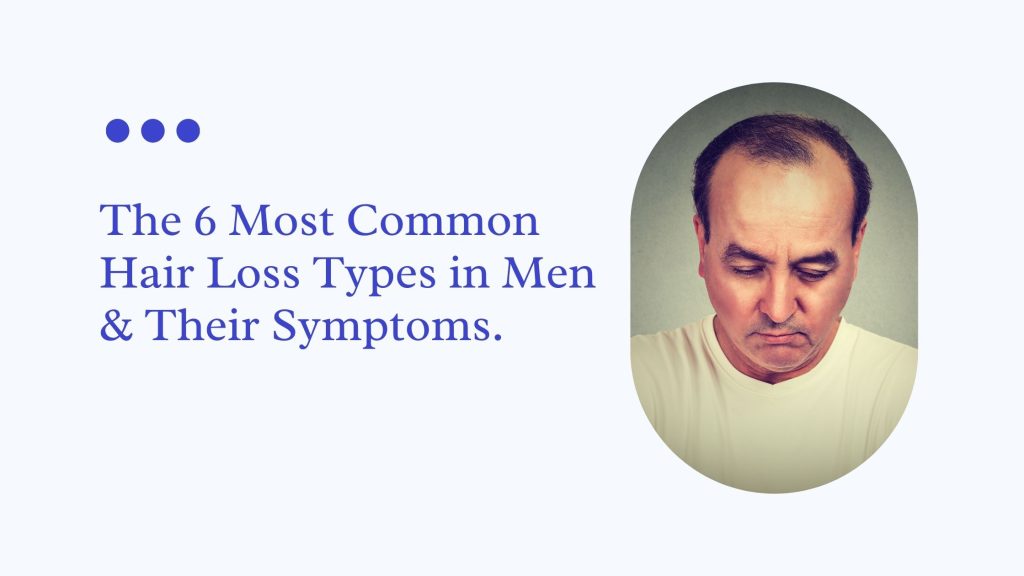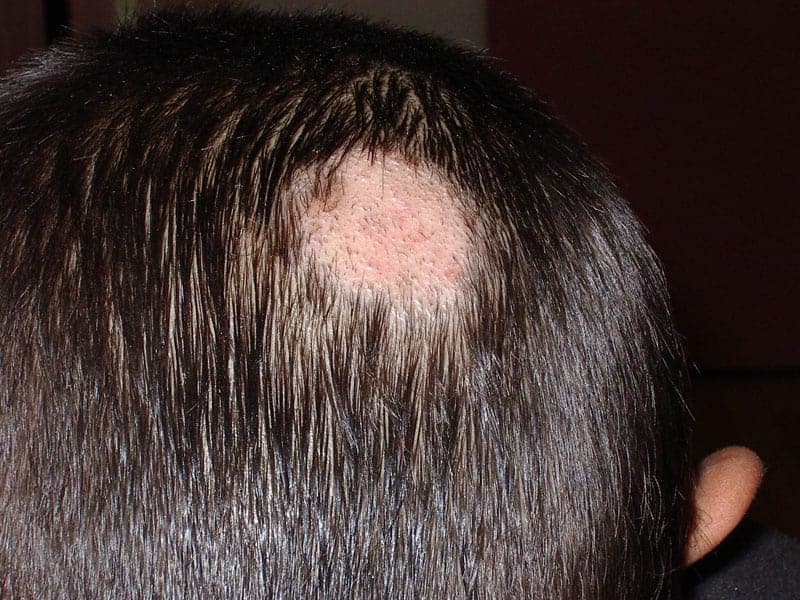
Hair loss is a common problem that affects millions of men worldwide. While it may seem like a minor issue, hair loss can have a significant impact on a person’s self-esteem and overall well-being. There are several different hair loss types in men, each with its own unique causes and characteristics. Understanding the various types of hair loss and their underlying causes is essential for finding effective treatment options. In this article, we’ll explore the different types of hair loss that are most common in men, including male pattern baldness, alopecia areata, and telogen effluvium. We’ll also discuss the potential causes and risk factors associated with each type of hair loss, as well as the available treatment options. Whether you’re experiencing hair loss yourself or simply want to learn more about this common condition, read on to discover everything you need to know about hair loss in men.
What Causes Hair Loss in Men?
Genetics
Genetics play a significant role in determining an individual’s predisposition to hair loss. Androgenetic Alopecia, or Male Pattern Baldness, is the most common type of hair loss in men and is primarily hereditary. It is linked to the presence of a hormone called dihydrotestosterone (DHT), which causes hair follicles to shrink and produce thinner, shorter hair. Over time, the affected follicles may stop producing hair altogether, leading to baldness. The likelihood of developing this condition increases with age and is inherited from either parent.
Hormonal Imbalances
Hormonal imbalances, particularly involving androgens like testosterone and DHT, can contribute to hair loss in men. Excess production of DHT can negatively impact hair growth by shortening the hair follicle’s growth phase and causing them to shrink. Conditions such as polycystic ovary syndrome (PCOS) or thyroid disorders can also lead to hormonal imbalances, although these are less common in men.
Stress
Prolonged stress and anxiety can cause hair loss by triggering a condition called Telogen Effluvium. This occurs when a significant number of hair follicles prematurely enter the resting phase (telogen), causing hair to fall out more rapidly than usual. Additionally, stress can lead to scalp conditions like dandruff or seborrheic dermatitis, which can further contribute to hair loss.
Nutritional
A well-balanced diet is crucial for maintaining healthy hair. Deficiencies in essential nutrients such as iron, zinc, biotin, and protein can negatively affect hair growth and contribute to hair loss. Crash diets, restrictive eating habits, or certain medical conditions can lead to these deficiencies, making it important to consume a varied and nutritious diet to support hair health.
Medical
Hair loss can be a side effect of certain medical conditions, such as lupus, diabetes, or scalp infections like ringworm. Some medications, including chemotherapy drugs, blood thinners, and certain antidepressants, can also cause temporary or permanent hair loss. It is essential to consult a healthcare professional if you suspect that a medical condition or medication is contributing to hair loss.
Hair loss Types in Men
Androgenetic Alopecia
Symptoms: Androgenetic Alopecia, also known as Male Pattern Baldness, is characterized by a receding hairline and gradual thinning of hair at the temples and crown[^2^]. Over time, this can progress into complete baldness on the top of the head, while hair remains on the sides and back. The pattern and rate of hair loss can vary among individuals.
Progression: This type of hair loss is typically progressive, meaning it worsens over time. It is driven by genetic and hormonal factors, with dihydrotestosterone (DHT) playing a crucial role in the miniaturization of hair follicles[^3^]. Early intervention can help slow down the progression and potentially regrow hair.
Telogen Effluvium
Symptoms: Telogen Effluvium is a temporary form of hair loss caused by a disruption in the hair growth cycle. This can lead to excessive shedding, with hair coming out in clumps during washing or brushing[^4^]. The hair loss is typically diffuse and affects the entire scalp, rather than specific areas.
Causes: This type of hair loss can be triggered by various factors, including stress, illness, surgery, hormonal changes, or nutritional deficiencies[^5^]. In most cases, hair growth will resume once the underlying cause has been addressed.
Alopecia Areata

Symptoms: Alopecia Areata is an autoimmune disorder characterized by sudden, round or oval patches of hair loss on the scalp or other areas of the body[^6^]. The affected skin usually appears smooth and healthy, without any accompanying redness or inflammation.
Causes: The exact cause of Alopecia Areata is unknown, but it is believed to be an autoimmune reaction where the immune system mistakenly attacks hair follicles[^7^]. Genetic factors, stress, or viral infections may contribute to the development of this condition.
Traction Alopecia
Symptoms: Traction Alopecia is hair loss caused by prolonged tension or pulling on the hair, often due to tight hairstyles like ponytails, braids, or extensions[^8^]. It typically results in thinning or bald patches along the hairline or behind the ears.
Causes: The continuous tension on the hair follicles weakens them and leads to hair loss. Repeated use of tight hairstyles, heavy hair extensions, or hair accessories can contribute to this type of hair loss. Early intervention and avoiding the cause can reverse Traction Alopecia.
Anagen Effluvium
Symptoms: Anagen Effluvium is characterized by sudden, widespread hair loss that occurs during the active growth phase (anagen) of the hair cycle[^9^]. This type of hair loss typically affects the entire scalp, and in severe cases, can also involve body hair.
Causes: Anagen Effluvium is most commonly associated with chemotherapy or radiation therapy, as these treatments can damage rapidly dividing cells, including hair follicle cells[^10^]. Other potential causes include certain medications, toxic exposure, or autoimmune diseases.
Scarring Alopecia
Symptoms: Scarring Alopecia, also known as Cicatricial Alopecia, is characterized by permanent hair loss accompanied by inflammation, redness, or scarring on the scalp[^11^]. This type of hair loss can be patchy or diffuse and may cause itching, burning, or pain.
Causes: Scarring Alopecia can be caused by various factors, including autoimmune conditions, infections, or inflammatory diseases.
Diagnosing Hair Loss in Men
Self-assessment
Conducting a self-assessment is the first step in diagnosing hair loss. Pay attention to changes in your hair, such as thinning, a receding hairline, or increased shedding during washing or brushing. It can be helpful to take photos over time to track any progression in hair loss. Note any potential triggers or factors that may be contributing to the hair loss, such as recent stress, changes in diet, or new medications. However, keep in mind that self-assessment is not a substitute for professional advice. If you are concerned about your hair loss or notice significant changes, it is important to consult a medical professional for a proper diagnosis.
Consultation with a Medical Professional
Consultation with a healthcare professional, such as a dermatologist or trichologist, is an essential step in diagnosing the cause of hair loss. During the consultation, the professional will ask about your medical history, family history of hair loss, and any medications or supplements you are taking. They will also inquire about your diet, stress levels, and hair care practices. A thorough physical examination of your scalp and hair will be conducted to identify any visible signs of hair loss or underlying scalp conditions.
It is crucial to be open and honest during the consultation, providing accurate information about your symptoms, lifestyle, and any potential triggers. This will help the healthcare professional determine the most likely cause of your hair loss and recommend the most appropriate course of action.
Diagnostic Tests
Depending on the results of the consultation and physical examination, the healthcare professional may recommend further diagnostic tests to determine the cause of your hair loss. These tests may include:
- Blood tests: Blood tests can help identify underlying health conditions or hormonal imbalances that may be contributing to hair loss. Common tests include complete blood count (CBC), thyroid function tests, and iron levels. In some cases, tests for specific hormones like testosterone, DHT, or prolactin may also be conducted.
- Hair pull test: This test involves gently pulling on a small section of hair to assess the amount of hair that comes out. If more than 10% of the hairs in the tested section come out, it may indicate an active hair loss problem.
- Trichoscopy: A trichoscope is a handheld device that magnifies the scalp, allowing the healthcare professional to examine the hair follicles and identify any signs of hair loss or inflammation. This non-invasive test can help diagnose various hair loss conditions, such as Androgenetic Alopecia, Alopecia Areata, or Scarring Alopecia.
- Scalp biopsy: In some cases, a small scalp biopsy may be necessary to diagnose the cause of hair loss. This involves removing a tiny sample of scalp tissue, which is then examined under a microscope. A scalp biopsy can help identify signs of inflammation, scarring, or fungal infections that may be contributing to hair loss.
- Hair mineral analysis: This test involves analysing a small sample of hair to determine the levels of various minerals and heavy metals. Hair mineral analysis can help identify nutritional deficiencies or toxic exposure that may be contributing to hair loss.
References
- American Academy of Dermatology Association. (n.d.). Hair loss: Overview. Retrieved from https://www.aad.org/public/diseases/hair-loss
- Mayo Clinic. (2020, June 12). Hair loss. Retrieved from https://www.mayoclinic.org/diseases-conditions/hair-loss/symptoms-causes/syc-20372926
- Harvard Health Publishing. (2019, April). Treating male pattern baldness. Retrieved from https://www.health.harvard.edu/mens-health/treating_male_pattern_baldness
- American Academy of Dermatology Association. (n.d.). Hair shedding: What is normal? Retrieved from https://www.aad.org/public/everyday-care/hair-scalp-care/hair/shedding
- Mounsey, A., & Reed, S. W. (2009). Diagnosing and treating hair loss. American Family Physician, 80(4), 356-362. Retrieved from https://www.aafp.org/afp/2009/0815/p356.html
- American Academy of Dermatology Association. (n.d.). Alopecia areata: Overview. Retrieved from https://www.aad.org/public/diseases/hair-loss/types/alopecia-areata
- National Institute of Arthritis and Musculoskeletal and Skin Diseases. (2016, September). Alopecia areata. Retrieved from https://www.niams.nih.gov/health-topics/alopecia-areata
- American Academy of Dermatology Association. (n.d.). Traction alopecia. Retrieved from https://www.aad.org/public/diseases/hair-loss/types/traction-alopecia
- Miteva, M., & Tosti, A. (2012). Anagen effluvium. In Dermatologic Clinics, 30(3), 429-434. Retrieved from https://doi.org/10.1016/j.det.2012.04.009
- National Cancer Institute. (2018, April 6). Hair loss (alopecia). Retrieved from https://www.cancer.gov/about-cancer/treatment/side-effects/hair-loss
- American Academy of Dermatology Association. (n.d.). Scarring alopecia. Retrieved from https://www.aad.org/public/diseases/hair-loss/types/scarring-alopecia
